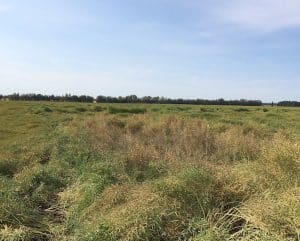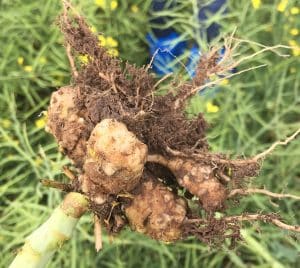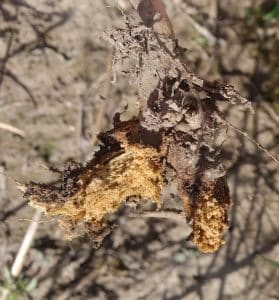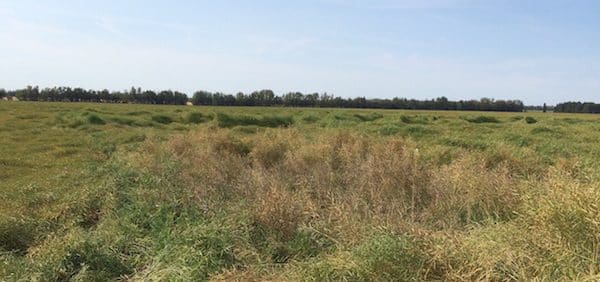Scouting plants
Targeted scout. In the weeks before harvest, look for plants with obvious symptoms. Look for patches of plants that are ripening prematurely and unusually. For instance, plants growing in the fringe around low wet areas are often large and green and healthy. If these plants are dying or dead instead, this could be a clubroot patch. Carefully dig up roots and look for galls, especially around the top of the taproot.
If plants are already dead, galls may be decayed. In this case, stems may come out of the ground with no roots attached – which can make clubroot seem like root rot. In this situation, dig down and look for brownish sawdust-like material around where the tap root would be. This is likely decayed galls. DNA tests can confirm this. (See the list of labs below.)
While at this location, move beyond these dead areas by a foot or two and check the first living plants. Carefully shovel up the tap root and knock away soil to check for galls. When plants are still living, galls are white and fleshy, like a potato. Large galls can be the size of a plum, and grape-sized galls are common.
Random scout. Plants that appear healthy can still have galls – and these galls will produce spores that can be spread around the field and then infect canola the next time around. Random scouts in high-risk areas can find these plants. The highest-risk areas for introduction of clubroot tend to be field entrances where incoming machinery is unfolded and where work begins. That is where infested soil from this machinery drops at the highest concentrations.
Select random plants in these areas for gall checks and lab tests. Because clubroot tends to be in patches, walking around pulling plants every couple of feet or pulling 10 plants every several feet should increase your odds of finding the disease. Some surveys use a W pattern in from the entrance, pulling 10+ plants at all five points of the W pattern.
Other hotspots for clubroot include water-runs, low/wetter areas, areas alongside neighbouring infested fields, areas with heavy traffic (lease roads, yardsites) and areas downwind from loading areas/bins where dust tends to accumulate.
Weed scout. Another scouting option is to check for patches of green weeds. Weeds are often worse in patches where plants died off prematurely due to clubroot. Brassica weeds such as mustard, stinkweed and shepherd’s purse will host clubroot and form galls, so weed patches can contribute to the built up soil spore loads. If these weeds have galls, then clubroot is present in the field.



Scouting soil
Another option is to have the soil tested for clubroot DNA. Here are labs in Canada that currently provide clubroot DNA analysis of soil and/or plant material:
20/20 Seed Labs
507 11th Ave
Nisku, AB
T9E 7N5
(780) 955-3435
A&L Canada Laboratories Inc.
2136 Jetstream Road
London, ON
N5V 3P5
(519) 457-2575
Exova
7217 Roper Road NW
Edmonton, AB
T6B 3J4
(780) 438-5522
SGS BioVision
#310 – 280 Portage Close
Sherwood Park, AB
T8H 2R6
1-800-952-5407
Discovery Seed Labs
450 Melville Street
Saskatoon, SK
S7J 4M2
(306) 249-4484
Pest Surveillance Initiative (PSI)
5A 1325 Markham Road
Winnipeg, MB
R3T 4J6
(204) 813-2171
More scouting tips
–Carefully examine the roots. There aren’t many other symptoms which resemble clubroot (hybridization nodules and sometimes group-4 injury can be mistaken for clubroot. If in doubt, send plant samples to a lab for further identification.
–If the soil is very dry or hard, the roots may shed off the plant as you pull it out of the ground. Digging up the plants and carefully remove soil or wash roots in a bucket of water to check for galls.
–Scouting can begin at the pre-bolting stage, but often the symptoms are more obvious later in the season, near swathing. Sclerotinia scouting timing is also a good time to scout for clubroot by pulling plants.
–Above-ground symptoms are rarely seen with early infestations unless the soil introduced was heavily infested.
Further reading:
Top 10 questions about clubroot
Read a Country Guide article about scouting from the air
Find more on clubroot identification, prevention and management at clubroot.ca.
